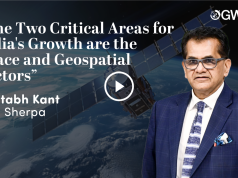One-day state-level workshop by Punjab Remote Sensing Centre, held in Chandigarh, throws light on the vital role of satellite data and geospatial information to stem stubble burning, and improve the agricultural practices.
Stubble burning has emerged as a serious recurring problem, which leads to cities getting shrouded in thick smog, aggravating pollution-linked health hazards.
As per estimates, each year farmers in Punjab burn over 7 to 8 million metric tons of crop stubble. Though, over the past couple of years, there have been innovative approaches to dissuade burning of stubble such as super seeder thrashers, use of crop residue as power plant fuel, and incentivizing sale of paddy fodder, the magnitude of the problem is immense.
In order to curtail it, there’s a need for more widespread adoption of geospatial and space technologies to observe, track, monitor, measure, and mitigate.
Satellites equipped with high-resolution cameras and sensors can detect fires and smoke, providing real-time data to authorities and researchers. This data is crucial in understanding the scale and impact of stubble burning.
“Multiple sources and historical standardized datasets helps with regular monitoring with a range of spectral to spatial resolutions over a wide range of area”, says Dr Vinay Kumar Sehgal, Principal Scientist, Division of Agricultural Physics, ICAR-Indian Agricultural Research Institute
Better Decision Making
The use of satellite imagery helps in identifying the exact locations of the fires, their intensity, and the affected area. This information is critical for authorities to take timely action and for researchers to study the environmental impact of such practices.
“In Punjab, satellite monitoring can play a crucial role informing the government officials in addressing the most pressing agricultural issue: stubble burning”, says Dr. Brijendra Pateriya, Director, Punjab Remote Sensing Centre (PRSC).
The raw data from satellites is processed and analysed using advanced algorithms. This involves filtering out noise, correcting for atmospheric disturbances, and interpreting the data to identify fire signatures.
This information is shared with local authorities, farmers, and environmental agencies. This timely information allows for quick response and planning of mitigation measures.
“GIS tools are employed to analyse the spatial extent and frequency of these fires. The processed data is then used to create maps and visualizations that clearly show the areas affected by stubble burning”, says Dr. Raj Setia, Senior Scientist, Punjab Remote Sensing Centre.
The process is continuous, providing ongoing surveillance of the region to track changes over time and assess the effectiveness of policies and practices aimed at reducing stubble burning.
Increasing Crop Yield
What needs to be widely known is that stubble burning not only causes severe spike in pollution level, but also reduces soil fertility, leading to net long-term loss for the farmers.
According to research, stubble burning strips the soil of essential NPK as well as other micro-nutrients.
Recognizing the various hazards of it, there are farmers who have started adopting an ex-situ crop residue management – the process of removing agricultural waste from the field for use as compost, firewood, or animal feed.
By providing farmers with detailed information about their land, such as soil health, moisture levels, and crop growth patterns, geospatial has enhanced crop yields and sustainability.
“There’s a need to diversify crops, supporting research into new methods of crop residue management, and encouraging farmers to grow a variety of crops”, says Shri. K A P Sinha, IAS Additional Chief Secretary, Department of Revenue, Rehabilitation and Disaster Management
Geospatial and satellite data also aids in precision farming, land use planning, and environmental conservation.




